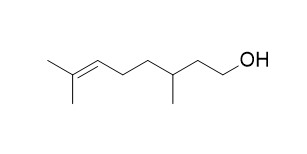beta-Citronellol
beta-Citronellol can controll Dermatophagoides farinae and D. pteronyssinus, it could be useful for managing populations of D. farinae and D. pteronyssinus.
Inquire / Order:
manager@chemfaces.com
Technical Inquiries:
service@chemfaces.com
Tel:
+86-27-84237783
Fax:
+86-27-84254680
Address:
1 Building, No. 83, CheCheng Rd., Wuhan Economic and Technological Development Zone, Wuhan, Hubei 430056, PRC
Providing storage is as stated on the product vial and the vial is kept tightly sealed, the product can be stored for up to
24 months(2-8C).
Wherever possible, you should prepare and use solutions on the same day. However, if you need to make up stock solutions in advance, we recommend that you store the solution as aliquots in tightly sealed vials at -20C. Generally, these will be useable for up to two weeks. Before use, and prior to opening the vial we recommend that you allow your product to equilibrate to room temperature for at least 1 hour.
Need more advice on solubility, usage and handling? Please email to: service@chemfaces.com
The packaging of the product may have turned upside down during transportation, resulting in the natural compounds adhering to the neck or cap of the vial. take the vial out of its packaging and gently shake to let the compounds fall to the bottom of the vial. for liquid products, centrifuge at 200-500 RPM to gather the liquid at the bottom of the vial. try to avoid loss or contamination during handling.
Pharmaceuticals (Basel).2024, 17(6):727.
Phytochem Anal.2024, pca.3319.
United States Patent Application2020, 20200038363
Asian Journal of Chemistry2018, 30(12):2699-2703
Eur J Pharmacol.2024, 963:176280.
Res Pharm Sci.2023, 18(3):244-261.
Drug Des Devel Ther.2023, 17:2461-2479.
Lab Chip.2018, 18(6):971-978
Food Res Int.2020, 128:108778
Key Engineering Materials2022, 931(47-53).
Related and Featured Products
J Microbiol Biotechnol, 2008, 18(10):1666-1671.
Mite-control activities of active constituents isolated from Pelargonium graveolens against house dust mites[Pubmed:
18955817]
METHODS AND RESULTS:
The mite-control activities of materials obtained from Pelargonium graveolens oil against Dermatophagoides farinae and D. pteronyssinus were examined using an impregnated fabric disk bioassay and were compared with those shown by commercial benzyl benzoate and N,N-diethylm- toluamide (DEET). Purification of the biologically active constituents from P. graveolens oil was done by silica gel chromatography and high performance liquid chromatography. The structures of the active components were analyzed by EI/MS, (1)H-NMR, (13)C-NMR, (1)H-(13)C COSYNMR, and DEPT-NMR spectra, and were identified as geraniol (C(10)H(18)O, MW 154.25, trans-3,7-dimethyl-2,6- octadien-1-ol) and beta-Citronellol (C(10)H(20)O, MW 156.27, 3,7-dimethyl-6-octen-1-ol). Based on the LD50 values, the most toxic compound was geraniol (0.26 microg/cm(2)), followed by beta-Citronellol (0.28 microg/cm(2)), benzyl benzoate (10.03 microg/ cm(2)), and DEET (37.12 microg/cm(2)) against D. farinae. In the case of D. pteronyssinus, geraniol (0.28 microg/cm(2)) was the most toxic, followed by beta-Citronellol (0.29 microg/cm(2)), benzyl benzoate (9.58 microg/cm(2)), and DEET (18.23 microg/cm(2)).
CONCLUSIONS:
These results suggest that D. farinae and D. pteronyssinus may be controlled more effectively by the application of geraniol and beta-Citronellol than benzyl benzoate and DEET. Furthermore, geraniol and beta-Citronellol isolated from P. graveolens could be useful for managing populations of D. farinae and D. pteronyssinus.
Carcinogenesis,1991 Jan;12(1):151-2.
Inhibition of azoxymethane-induced neoplasia of the large bowel by 3-hydroxy-3,7,11-trimethyl-1,6,10-dodecatriene (nerolidol).[Pubmed:
1988176]
METHODS AND RESULTS:
The inhibitory capacities of four terpenes on azoxymethane (AOM)-induced neoplasia of the large bowel and duodenum was studied in male F344 rats. A complete course of AOM administrations was given and 3 days later the rats were fed a semipurified diet containing 5 mg/g of the test compounds, i.e. 3-hydroxy-3,7,11-trimethyl-1,6,10-dodecatriene (nerolidol), beta-Citronellol, (+/-)-linalool and (1R,2S,5R)-(-)-menthol or a corresponding control diet. The experiment was terminated 22 weeks after the last dose of AOM. Under these conditions, nerolidol showed an inhibitory effect on carcinogenesis of the large bowel. The number of rats bearing large bowel neoplasms (adenomas) was reduced from 82% in the controls to 33% in rats fed nerolidol and the number of tumors/rat from 1.5 in the controls to 0.7 in the nerolidol group. A reduction in adenocarcinomas of the duodenum was found but the data are not statistically significant. The effects of nerolidol are of interest in terms of the identification of a new inhibitor of carcinogenesis of the large bowel.
CONCLUSIONS:
The chemical structure of nerolidol suggests the possibility that the compound might have an impact on protein prenylation or some other aspect of the mevalonate pathway, but this remains to be established.



